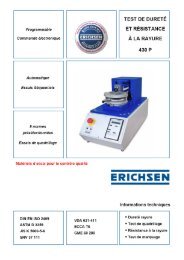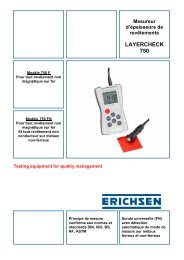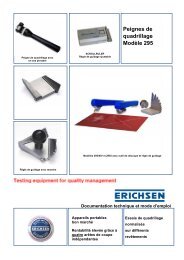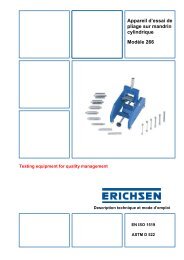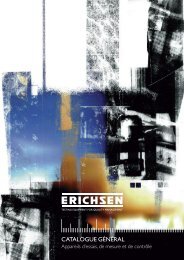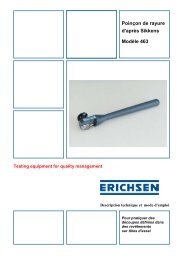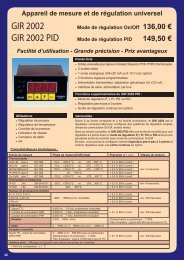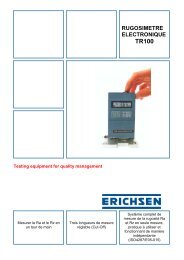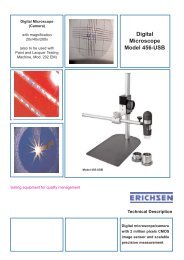Sheet Metal Testing Machine Model 102 - Erichsen
Sheet Metal Testing Machine Model 102 - Erichsen
Sheet Metal Testing Machine Model 102 - Erichsen
Create successful ePaper yourself
Turn your PDF publications into a flip-book with our unique Google optimized e-Paper software.
ERICHSEN Cupping Test<br />
Deep Drawing Cup Test<br />
Bore Expanding Test<br />
testing equipment for quality management<br />
Data Evalution Software with<br />
User Test Software<br />
Data logger for recording the<br />
measurements such as drawing<br />
and blank holder force<br />
and stroke<br />
ERICHSEN Cupping<br />
TestDeep Drawing Cup<br />
TestBore Expanding Test<br />
<strong>Sheet</strong> <strong>Metal</strong><br />
<strong>Testing</strong> <strong>Machine</strong><br />
<strong>Model</strong> <strong>102</strong><br />
Technical Description<br />
With electro-hydraulic<br />
drive and fully automatic<br />
test sequence
Product<br />
<strong>Sheet</strong> <strong>Metal</strong> <strong>Testing</strong> <strong>Machine</strong>, <strong>Model</strong> <strong>102</strong>, with<br />
electro-hydraulic drive, max. drawing force of 60 kN<br />
and automatic switch off at specimen failure.<br />
Application<br />
This <strong>Sheet</strong> <strong>Metal</strong> <strong>Testing</strong> <strong>Machine</strong> is intended for<br />
testing materials in the medium thickness range<br />
(0.1 to approx. 3.5 mm). It provides rapid an reliable<br />
quality monitoring for sheet metal producers and<br />
users.<br />
<strong>Model</strong> <strong>102</strong> is suitable for<br />
• the ERICHSEN Cupping Test on all ferrous and<br />
non-ferrous metals in accordance with<br />
ISO 8490 JIS Z-7729<br />
EN 14-58 UNI 3037<br />
EN 14-67 UNE 7080<br />
EN ISO 20482 GOST 10 510<br />
BS 38 55 ICONTEC 21<br />
NF A 03-602 SIS 11 26 35<br />
NF A 03-652 SABS 0132-197<br />
ASTM 643-84 GB 4156-84<br />
In addition, the Olsen Test as used in the USA<br />
can be performed on the testing machine when<br />
appropriate tools are set up.<br />
• the Deep Drawing Cup Test for the<br />
determination of the ear forming tendency and<br />
maximum drawing ratio according to<br />
DIN EN 1669 MSZ 5731-68<br />
DIN 50 155 GB/T 15825<br />
UNI 6124-67 ISO 11531<br />
• the Bore Expanding Test<br />
in accordance with Siebel and Pomp (KWI)<br />
ISO 16630<br />
Depending of the testing method the following sheet<br />
metal thicknesses can be tested:<br />
<strong>Erichsen</strong> Cupping Test 0.1 - 3.5 mm<br />
Deep Drawing Cup Test 0.2 - 1.5 mm<br />
Bore Expanding Test 0.2 - 2.0 mm<br />
The above mentioned maximum sheet thicknesses<br />
are based on material with a tensile strength of<br />
400 N/mm².<br />
There are important reasons for using the <strong>Sheet</strong><br />
<strong>Metal</strong> <strong>Testing</strong> <strong>Machine</strong>, <strong>Model</strong> <strong>102</strong>, for quality<br />
assurance:<br />
♦ Lowering of manufacturing costs by making spot<br />
checks on the drawing quality of cold rolled sheet<br />
during production or in the process department.<br />
♦ Sorting out of material of lower quality arriving at<br />
the Goods Inwards Department. Without special<br />
test preparation it is immediately possible to<br />
establish if the material supplied has the<br />
prescribed drawing quality.<br />
♦ Determining the most appropriate sheet thickness<br />
for a particular drawn workpiece to optimise the<br />
ratio of price to suitability for the manufacturing<br />
process.<br />
Quantitative measurement of sheet quality by means<br />
of the ERICHSEN Cupping Test provides a basis of<br />
communication between sheet metal producers and<br />
users.<br />
The form of the crack and the surface roughness<br />
(= grain size) also provide information on the quality<br />
of the sheet metal and is suitability for drawing,<br />
giving valuable information especially to the sheet<br />
metal producer.<br />
The good functional layout of <strong>Model</strong> <strong>102</strong> makes this<br />
machine particularly user friendly. Operators without<br />
previous knowledge or experience can be quickly<br />
trained to operate the machine continuously. All<br />
relevant test tools can be set up in the test cylinder<br />
quickly and without difficulty.<br />
The sturdy design and the hydraulic system<br />
employed ensure that minimum wear is experienced<br />
so that accurate test results are assured over a long<br />
period of time.<br />
Description<br />
The machine consists of a sturdy sheet metal<br />
housing into which the test aggregate (test cylinder<br />
with work piston, sheet holder piston) and the test<br />
tools as well as the hydraulic system are integrated.<br />
The operator's controls are arranged conveniently on<br />
a control panel. As an option, an electro-hydraulic<br />
blanking press for the manufacture of blanks for the<br />
Deep Drawing Cup Test can be fitted into the<br />
machine housing.<br />
When carrying out the ERICHSEN Cupping Test,<br />
the sheet metal specimen in the form of strip is<br />
inserted into the test cylinder and centralised by<br />
locating diagonally. The sheet holder force of 10 kN<br />
(in accordance with the standard) is adjusted using a<br />
special regulating valve, and the actual cupping<br />
process is initiated by selecting the standardised<br />
drawing speed on the speed regulator.
Since the testing machine is equipped with the<br />
function "automatic stop at specimen failure" the<br />
forward speed is automatically stopped when the<br />
crack occurs, so that in any case an objective test<br />
result is achieved. The ERICHSEN cupping value is<br />
displayed with an accuracy of 0.1 mm on the digital<br />
counter.<br />
When carrying out the Deep Drawing Cup Test, the<br />
round blank manufactured by the electro-hydraulic<br />
blanking press, is placed into an infinitely variable<br />
centring device located in the test cylinder. After<br />
preselection of the sheet holder pressure the blank is<br />
drawn by a drawing punch (normally 33 mm dia.) to a<br />
cylindrical hollow part, the socalled cup. The inner<br />
diameter of the drawing die used, corresponds to the<br />
sheet thickness to be tested. After return of the<br />
drawing piston to the starting position, the cup can<br />
be removed from the test head without any difficulty.<br />
When carrying out the Bore Expanding Test (KWI)<br />
the initial bore (in accordance with the dimensions of<br />
the tools, i. e. normally 7.5 mm or 12 mm) is applied<br />
to the sheet metal specimen by drilling and reaming.<br />
Afterwards this initial bore is expanded until a crack<br />
appears.<br />
Accessories<br />
The various accessories make this sheet metal<br />
testing machine particularly versatile. For further<br />
detailed specifications please see our Price List<br />
No. <strong>102</strong>.<br />
Data Evalution System with user test software, PC,<br />
monitor and printer for data evalution (under WIN<br />
2000/XP) for the ERICHSEN Cupping Test and Deep<br />
Drawing Cup Test.<br />
Details see back page.<br />
Data logger for recording the measurements such as<br />
drawing and blank holder force and stroke by time;<br />
the connection is made by a USB connection to an<br />
external PC (to be supplied by the user). The<br />
software included in the scope of supply runs under<br />
WIN 2000/XP. The system consisting of measuring<br />
transducer for drawing force and analogue output for<br />
the stroke as well as the corresponding interfaces,<br />
A/D converter module.<br />
Test Tools for the ERICHSEN Cupping Test<br />
♦ Test tools for the ERICHSEN Cupping Test in<br />
accordance with EN ISO 20482.<br />
Test Tools for the Deep Drawing Cup Test<br />
♦ Electro-hydraulic<br />
force 200 kN)<br />
Blanking Press (blanking<br />
♦ Deep Drawing Cup Test Tool B1 (drawing<br />
punch 33 mm dia.)<br />
♦ Test Tools for Earing Test on non-ferrous<br />
metals in accordance with DIN 50 155<br />
♦ Ear Measuring Instrument, <strong>Model</strong> 126, for rapid<br />
measurement of ears formed on cylindrical cups<br />
of diameters from 15 to 50<br />
♦ Ear Measuring Instrument, <strong>Model</strong> 126 C, for<br />
rapid measurement of ears formed on cylindrical<br />
cups of diameters from 20 to 100 mm.<br />
Test Tools for the Deep Draw Bore Expanding<br />
Test acc. to Siebel and Pomp (KWI)<br />
♦ Bore expanding test tool D (initial bore 12 mm)<br />
♦ Bore expanding test tool E (initial bore 7.5 mm)<br />
♦ Boring jig for drilling the initial bores<br />
♦ Drills, drilling bushes and reamers<br />
Additional Facilities for Tests on lacquered sheet<br />
metal specimens according to DIN ISO 1520<br />
♦ Special microscope with holder and illumination<br />
for optical observation of the test procedure<br />
Technical Data<br />
Dimensions Width 650 mm<br />
Height 1100 mm<br />
Depth 620 mm<br />
Weight, net approx. 150 kg<br />
Main supply 230 or 400 V, 3~, 50 Hz<br />
Motor performance 1 kW<br />
Drawing force max. 60 kN<br />
Blank holder force max. 12 kN<br />
Drawing speed max. 220 mm/min<br />
Punch stroke max. approx. 40 mm<br />
Indication of punch stroke digital<br />
(accuracy 0.,1 mm)<br />
Drawing punch diameter max. 33 mm<br />
Blank diameter max. 75 mm<br />
Order Informations<br />
Ord.-No. Product-Description<br />
0012.01.31 <strong>Sheet</strong> <strong>Metal</strong> <strong>Testing</strong> <strong>Machine</strong>,<br />
<strong>Model</strong> <strong>102</strong><br />
Supplied with:<br />
♦ Test Tool No. 27<br />
♦ One Filling of Hydraulic Oil<br />
♦ Operating Manual<br />
Further details and accessories please see our Price List<br />
No. <strong>102</strong>.
Modified ERICHSEN Cupping Test<br />
The ERICHSEN Cupping Test (in accordance with EN ISO 20482, and corresponding to national and international<br />
standards) is a test providing simple and quick means of assessing the multi-axis ductility of sheet and strip using a<br />
procedure that relates closely to practical processes. The depth range reached at failure is, however, only an initial<br />
guide to the evaluation of the forming properties of the sheet metal.<br />
Data Evalution System with User Test Software<br />
The software enables the continuous acquisition of<br />
measured values with simultaneous display of the<br />
force/displacement diagram throughout the forming<br />
process. Once the maximum force has been reached,<br />
the movement of the drawing punch is stopped<br />
automatically and the diagram is evaluated by the PC.<br />
Simultaneously, the measurements taken are<br />
processed further using a theoretical model for the<br />
plastic deformation of the material based on work done<br />
in association with the University of Siegen/Germany.<br />
On this basis, the equipment not only provides values<br />
for the normal ERICHSEN Cupping Test result -<br />
ERICHSEN Index IE - but also for elongation at failure<br />
AE, tensile strength RmE, and the n-value nE. (The<br />
suffix E indicates that the parameter has been<br />
measured using the ERICHSEN process.)<br />
The right of technical modifications is reserved.<br />
TBE <strong>102</strong> - VIII/2007<br />
This data is presented immediately on the VDU on<br />
completion of the test alongside the graph of the<br />
force against displacement. Either a printout can then<br />
be obtained and the data saved or the data can be<br />
easily transfered to other evaluation programmes<br />
(e.g. Microsoft Excel). Practical experience has<br />
shown that these new ERICHSEN parameters have<br />
a good correlation with corresponding values<br />
obtained conventionally, with the significant<br />
advantage that the considerable effort required to<br />
prepare conventional test specimens is eliminated.<br />
The scope of supply includes PC, VDU and printer.



